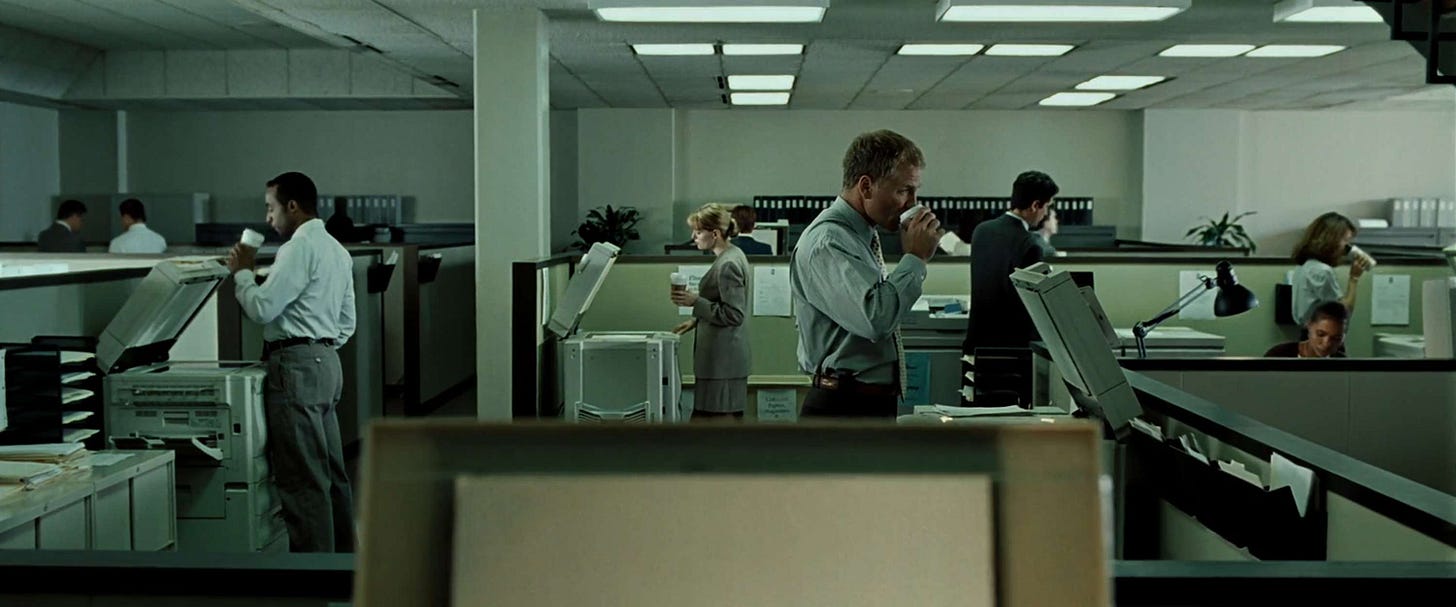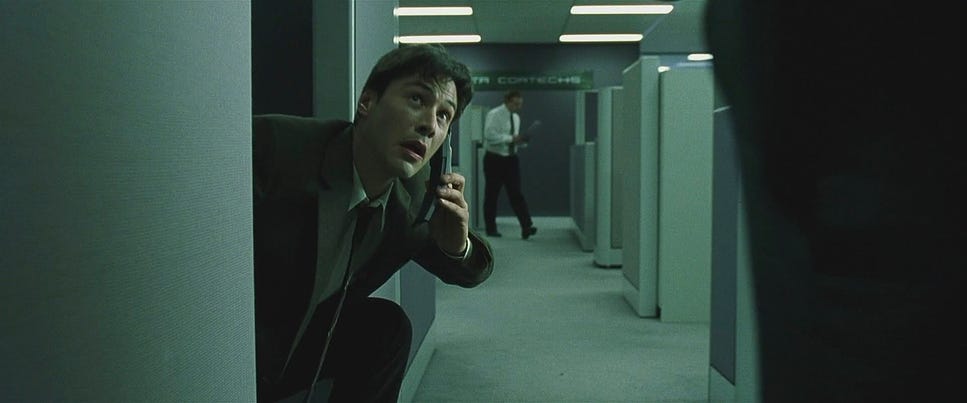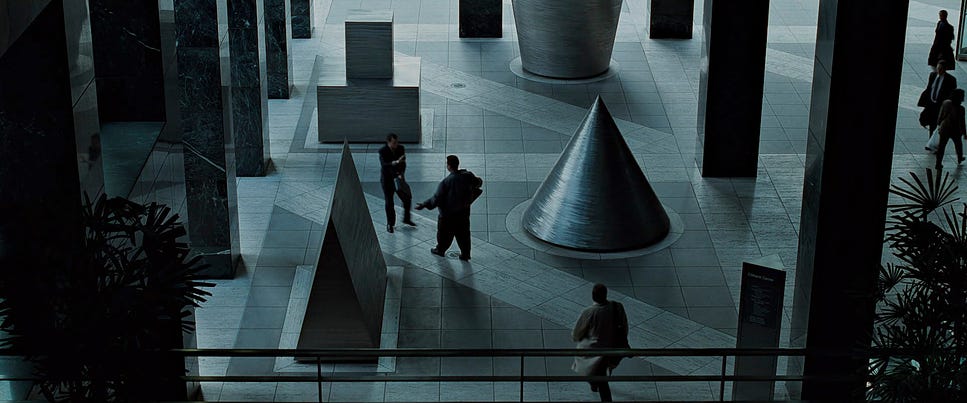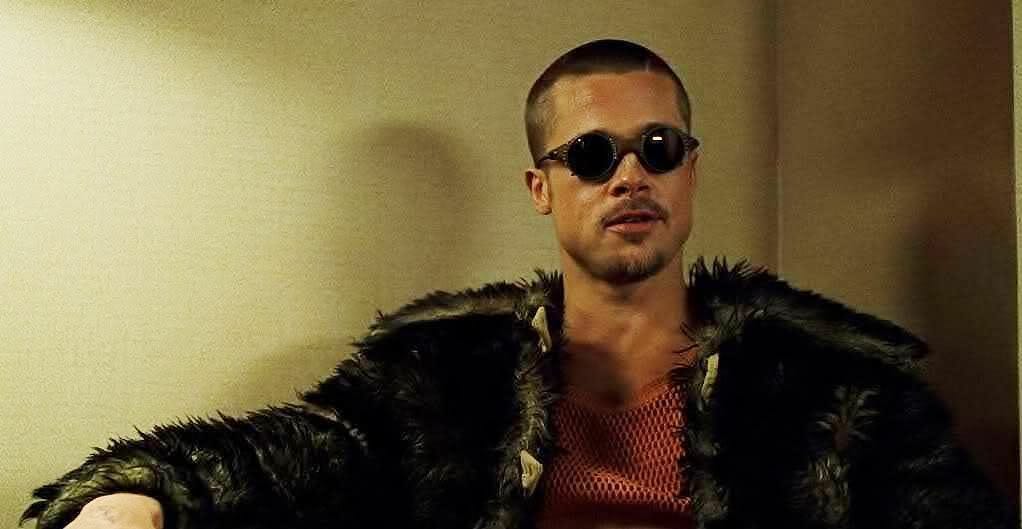🎬 #48 Free Your Mind: Film In The Year 1999 - Part One.
This issue of the newsletter is a special two parter - a bit longer, maybe a bit more essay-y than usual and in a slightly different format. The shared themes and concerns of the films over the next two weeks are something I’ve wanted to write about for a long time.
The dawn of Y2K seems to have been a period that distilled several filmmaker’s takes on existential dread, identity crisis, and a whole lot of rage against the machine into a single year. A year that may be one of my favourites in all cinema. One that really struck a cord with me during a time I was developing a deeper appreciation for film as an inquisitive, intrigued 14 year old.
As a collective these four films [over the next two weeks] are about humanity escaping the clutches of a world we were’t designed to fit into. They’re a fuck you to the manufactured existence we unknowingly find ourselves swallowed up in and an anarchic nod that reminds us to inject a little creative mayhem into our lives.
Happy choosing, happy viewing
Bry
THE SHARED DNA OF ANARCHY IN FIGHT CLUB AND THE MATRIX.
Fight Club, 1999 Dir David Fincher | The Matrix, 1999 Dir The Wachowskis
‘Jack,’ the title bestowed on the unnamed narrator of Fight Club spends a lot of his mental energy not being at work in his corporate job. Before he meets Tyler Durden and is set ‘free,’ he’s a caged drone, slave to the cubicle of his fluorescent painted office, jailed in his ultra modern flat pack apartment building, a numbered passenger strapped down inside a cylindrical jet liner prison, ferrying him to his next prescribed business action item. The same is true of Neo, before he meets Morpheus, he’s locked in a cubicle from which he literally can’t escape. Fincher and his team, just like the Wachowskis paint this world as an antiseptic, soulless entity that has its greedy grip firmly on the protagonist for the first act of the film.
Neo desires a path out of these shackles, he has to trust in the guidance of his new mysterious guru to lead him out of this life he feels isn’t really him. Similarly, ‘Jack’s' yearning for something outside the rectangular cubicle, corporate art, industrially packaged in-flight meals and corporate skinny no foam lattes, leads him to literally blow up the metal and glass towers that have scourged his existence. Whose shadows have robbed him from the warmth of his weird, angry, funny humanity for far too long. In Fight Club the final mission that destroys his old way of life comes from blowing up the buildings that have imprisoned him, in the Matrix, Neo has to leap off them to leave his old life behind - to become the ‘one.’
“Operator, I’m near 1888 Franklin Street”
This sterile, pre-packaged existence is rendered in the green hues of overhead lights, sickeningly mirroring the corporate logo of one of Fight Club’s world’s key sponsors - Starbucks. Alex McDowell, one my favourite production designers, makes this dull world feel inescapable, grey, green barely bleeds into white, so that the narrator’s dull anonymous suits and shirts make him blend into the background, a uniform that makes him feel like just another component in the mass-produced decor. Fincher’s millimetre perfect blocking and framing renders people in the office as cutouts, worker bees in their pre-loaded rubber stamped position, in their place - enacting their routine, like machines.
Jeff Cronenweth’s lens, numbed by the haze of kino flo lights, baths everything in that sickly green, the total opposite of natural skin tone. You could imagine Agent Smith walking into the frame above, navigating the grid of cubicles, trying to find Mr Anderson. Spot the difference.
The Matrix’s cinematography by Bill Pope, as you’ll recognise, goes all in on this computer green to depict the artificial ‘robotic’ world of simulated reality - sounds a lot like the world Edward Norton’s character finds himself plugged into. A routine of meetings and spaces. Even the CGI bin for the ‘galaxy of trash’ sequence in Fight Club lends the environment a plasticy, unreal, unnatural feel - fake-ness within fake-ness.
In many ways the manner in which Fincher and the Wachoskis handle the cubicle-d office environment feels like a dark pastiche of corporate stock footage - the iconic things that spring into our collective imagination when we think ‘corporate cubicle life.’ The thing to rebel against symbolised as the home of ‘faceless’ business men - the suit and tie armies. Even lines in the narration, ‘cornflower blue tie,’ and snippets of dialogue - ‘these are your primary action items,’ paint a soulless corporate prison from which ‘Jack’ and Neo are about to be liberated. Tyler Durden is to ‘Jack’ what Morpheus is to Neo, a liberator, an instigator - someone who’s spent their whole life searching for them, from outside and from within. Their purpose is to shake them out of their anaesthetised existence and enable them to become the person that represents their truest form, or at least the identity who’s able to escape the life they’re disillusioned with.
The ‘real world’ where both protagonists ‘find’ themselves are utilitarian, crumbling. But it’s here their new identities are formed - where they become punks. Even their respective costuming, designed by Michael Kaplan in Fight Club and Kym Barrett in The Matrix, share a potent connection. Gradually there’s a disrobing of who they are, and a step into who they will become. ‘Jack’ loses his shirt and tie until in the end he’s left in underwear and not much else, while Neo loses his shirt and tie and slips into an all black leather world. ‘Leather outfits that will last us the rest of our lives,’ a line Durden’s phantom whispers to his Space Monkeys, feels like the brief for The Matrix’s wardrobe design. A step into raw punk utility - purity of personality.
The man and woman in red.
Durden appears first as a series of flash frames, if you’ve seen the film you’ll already know this, even if you haven’t, you’ve probably heard of it. [Quality assurance actually flagged the single frames as having ‘dirt’ on them before the prints went out to cinemas]. He appears in a red leather jacket lit like a dirty, used devil, ready to cause chaos - the total opposite of the people he finds himself momentarily surrounded by. Like the yang of Agent Smith, he’s an agent of chaos in a clinical world, popping in from out of nowhere ready to break the rules, not enforce them, ready to free the ‘one’ not capture him. Like the woman in the red dress from The Matrix, he’s also symbol of desire - someone you’d want to be or be with - a refreshing breath of energy in a world where everyone looks and acts the same. He represents the break from the system that so many of us seek - in one of Durden’s surmons he tells us ‘I am free in all the ways you are not.’
Morpheus’ Project Mayhem.
As both films’ progress, the levels of rebellion against the world they’re at war with ramps up. Their armies, the agents of destruction, become more militant, they destroy the lobbies of buildings in elaborate missions, or the art that you might find there. The design and architecture they attack is the power symbol of the world they’re up against, a world that symbolises order and control. Progressively they take the power back. The narrator spurred on by Durden and Neo spurred on by Morpheus.
‘You are not your job or how much money you have in the bank’ - bespectacled gurus show us the way.
It’s only once they have ‘died,’ Neo taking bullets to the chest, ‘Jack’ putting a gun in his own mouth, can they be truly free, unbound from the world of control and imprisonment they started in - they are masters, no longer slaves. They are who they are, not who society told them to be.
Where Is My Mind? by The Pixies and Wake Up by Rage Against The Machine send us amped up into this new land of possibility beyond obedience to old ideals - the Year 2000.












